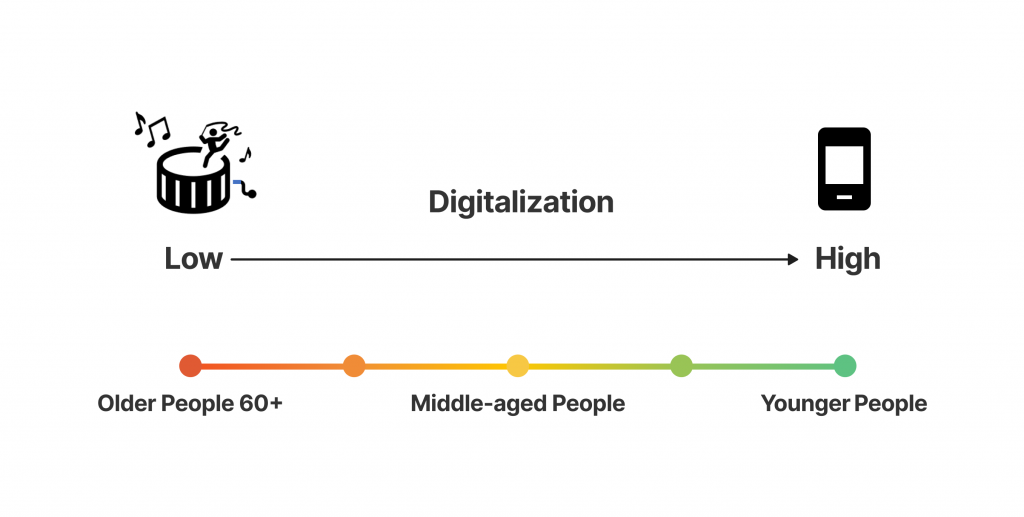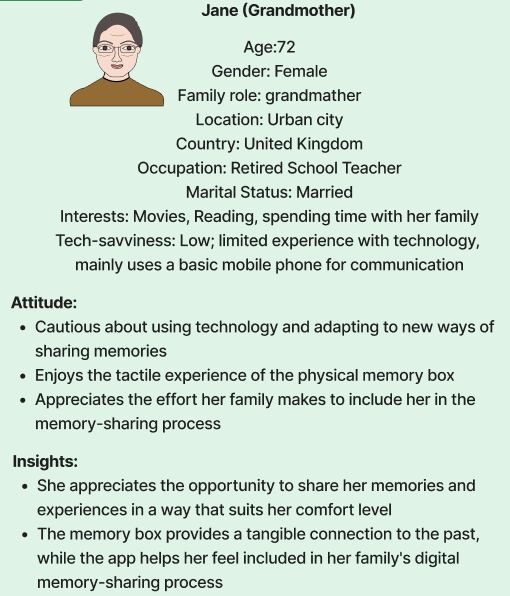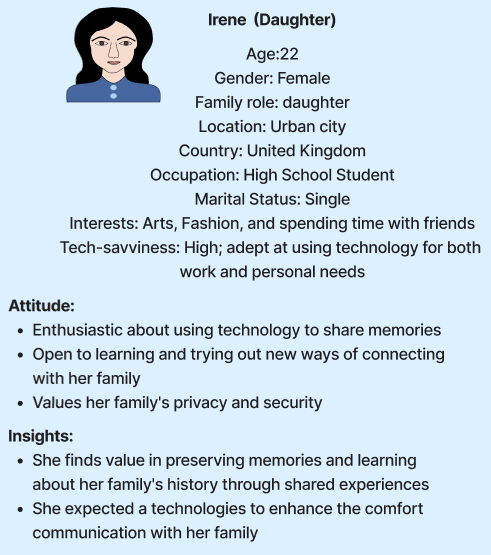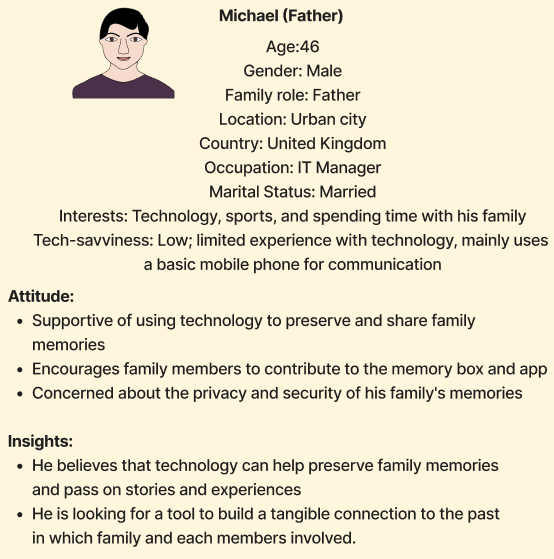Project: Memory Bank
Problem Statement
Memory is a crucial facet of both individual and collective identity. Retired conference managers, for instance, can offer valuable insights into their past and share memories to enhance social connections. However, as people enter middle age, their physiological functions gradually decline, and certain underlying medical conditions like hypertension and diabetes can lead to brain nerve damage and memory loss. Shared family memories are vital in maintaining familial bonds and, in most cases, it is the elderly who play a central role in this process. Unfortunately, the current market lacks memory and emotional memory products designed for older adults. In response, we propose a digital memory box that leverages digital tools to replace the human brain, providing a personalized, physical, and confidential avenue for storing memories and bolstering older adults’ initiative and emotional engagement with their past.
Design Approach
- Human-centered design
- System design
- User-centered design
Process Overview
- Research
- Ideation
- Product design
- Prototyping
- Testing
- Reflection
Conclusion
We see Memory Bank as a truly innovative solution to the problem of family connection. Memory Bank can be used as a shared family cloud memory centre where future generations can create and upload family stories and customise specific clips online as gifts for their elder parent.
In the context of the aging of the UK, it is important to explore older people’s needs. The UK population is undergoing a massive age transition, with people over 60 becoming the fastest-growing group in society (Age UK, 2023). There were more than 11 million people aged 65 or older in 2022, accounting for 19% of the total population, which is expected to increase to 13 million in ten years, accounting for 22% of the total population (Centre for Aging Better, 2022).
Older people in the UK experience high levels of loneliness as they age, mainly due to living alone, the digital divide, and physical illness. The data shows that the number of people living alone in middle and later life continues to grow, increasing by 67% between 2000 and 2019, and there are now 1.3 million men aged 65 and over living alone. Nearly a third of people aged 65 and over live alone, and 1.4 million say they often feel lonely(Stand Alone, n.d.). Although there are also many young people who live alone, they can meet their emotional needs through the Internet. While the elderly as digital immigrants are facing a large digital divide, and although some of them are eager to keep in touch with their families through digital tools, most of them cannot use digital devices well (Singer, 2020). On the other hand, the elderly with illnesses also experience increased loneliness as they spend less time with their families. They become more distant from those around them due to mood changes and depression. People with the disease can also be unable to do things that used to be easy and end up having a harder time getting out and meeting others. One in 10 people with dementia sees friends and family less than once a fortnight (WaveLength, n.d.).
It can be seen that the various problems faced by the elderly lead to increased loneliness, so there is a need to find a way to solve this problem. Research shows that family interactions can directly improve physical and mental health (No Isolation, n.d.). Sharing family stories can naturally connect grandparents with grandchildren, thereby alleviating feelings of loneliness (AARP, n.d.). Bruce Feiler (2013) highlights that sharing family stories, even the less flattering ones, can bring families closer together. Therefore, recording and storing the stories of family members will help to promote harmonious family relationships and meet older people’s emotional needs.
Considering the above factors, it is difficult to separate the elderly to solve their loneliness problem. Putting the elderly in the family network can better meet their emotional needs. By splitting the family relationship, it can be divided into three parts: the elderly (60+), middle-aged parents, and young people. As time goes by, other family members will become elderly and will face the same problems, so everyone should participate in the process of sharing and building family digital assets.

Personas

Age UK (2023) Who we are and what we do. Available at: https://www.ageuk.org.uk/about-us/people/ (Accessed: 18 April 2023)
AARP. (n.d.). How to Create an Oral Family History. Available at: https://www.aarp.org/home-family/friends-family/info-07-2013/oral-family-history-tree-stories.html (Accessed: 18 April 2023)
Centre for Ageing Better (2022) Summary | The State of Ageing 2022. Available at: https://ageing-better.org.uk/summary-state-ageing-2022 (Accessed: 18 April 2023)
No Isolation (n.d.) Why family is the secret to better health outcomes. Available at: https://www.noisolation.com/research/why-family-is-the-secret-to-better-health-outcomes (Accessed: 25 April 2023).
Office for National Statistics (2019) Families and households in the UK: 2019. Available at: https://www.ons.gov.uk/peoplepopulationandcommunity/birthsdeathsandmarriages/families/bulletins/familiesandhouseholds/2019 (Accessed: 18 April 2023)
Singer, N. (2020) ‘Older Adults Learning Tech to Stay Connected to Family During Pandemic’, The New York Times, 27 March. Available at: https://www.nytimes.com/2020/03/27/technology/virus-older-generation-digital-divide.html (Accessed: [insert date accessed here]).
Stand Alone (n.d.) The first UK charity to support estranged adults in their localities. Available at: https://www.standalone.org.uk/about/ (Accessed: 18 April 2023)
WaveLength (n.d.) Loneliness and Dementia. Available at: https://wavelength.org.uk/loneliness-and-dementia/?gclid=CjwKCAjw9J2iBhBPEiwAErwpeS5-auzBPfvhpM5TwCLQ2eiQ6MyYsNstwzacTv8KTETNQG0Tjh1KBRoCyL8QAvD_BwE (Accessed: 25 April 2023).

